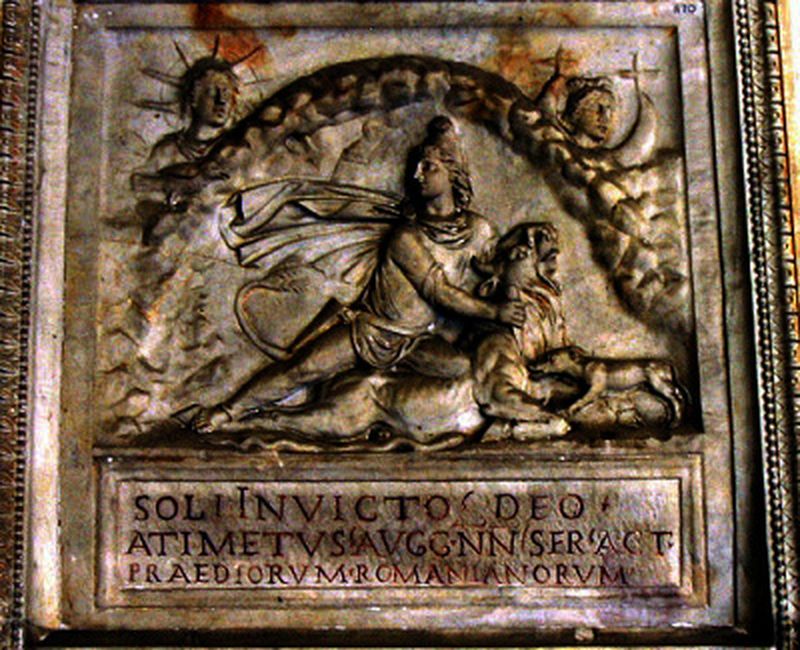The winter solstice and the God Mithras
With the Winter Solstice the so-called “Return of Light” is celebrated, in ancient pagan Rome, on a date between 21 and 25 December, the rebirth of the Sun was solemnly celebrated, the Dies Natalis Solis Invicti, the Sun Invitto, which in the Roman Empire was connected to the cult of Mithras, is a festival of rebirth which, for many historians, would represent the pagan origin of Christmas.

Solstice, derives from solis statio , that is, the stopping of the sun before embarking on a new cycle.
A festival, ab-origin pagan, widespread in many European and Eastern cultures, based on the ancient observation of the motion of the sun , which merged with the Christian tradition, giving life to a whole series of curious recurrences halfway between the sacred and the layman.
With the Winter Solstice, the so-called “Return of Light” is celebrated, that is to say it is the day when at an astronomical level, the sun is exactly “above” the Tropic of Capricorn, the Zenith, starts from this day, the coldest season of the year.
Furthermore, December 21st of this year represents the shortest day of the year and the longest night, already from December 22nd, the days will lengthen again, and the Sun begins its ascending path again .
Popular wisdom, however, has it that the shortest day of the year is December 13, in which Saint Lucia is celebrated, this difference depends on the fact that in the Julian calendar the day of the winter solstice actually fell on December 13, then, with the reorganization of the calendar wanted by Pope Gregory XIII in the sixteenth century, it was moved forward.
Read also The winter solstice >>
In ancient Egypt, a virgin was celebrated who “gave birth” to the sun , in ancient Rome it was the Sol Invictus, the “unconquered sun”, which does not succumb to the dark, but rather “rises” to restore life, later associated with Christmas and the birth of Christ.
Events related to the movements of the sun, have been celebrated by various ancient peoples, just look at the megalithic constructions of Stonehenge , in Great Britain, of Newgrange, Knowth and Dowth, in Ireland, Carnac in Normandy, the rock engravings of Bohuslan, in Iran, already in prehistoric and protohistoric times.
In fact, in the Winter Solstice, Indo-European and Celtic rites converge, exalting the powers of light and fire, of the waters and of the sleeping earth, under a blanket of snow, waiting for the awakening.
In this festival, according to an ancient belief, the Sun (fire) marries the Moon (water): hence the rites and uses of bonfires and dew, present in the peasant and popular tradition.
In ancient pagan Rome, on a date between 21 and 25 December, the rebirth of the Sun was solemnly celebrated, the Dies Natalis Solis Invicti, the Invicting Sun, which in the Roman Empire was connected to the cult of Mithras , is a festival of rebirth which, for many historians, would represent the pagan origin of Christmas.
The resumption of the ascending path of the sun therefore takes on multiple spiritual meanings, first of which the cosmic regeneration in which the Sun and the Light are associated with the idea of man’s immortality and the path that it must follow, bringing about its spiritual rebirth. .
Which resulted in a real: Cult of Light
It is also the time in which we can receive the maximum of solar power: the mystical force that unites heaven and earth is now stronger.
Monuments such as menhirs, dolmens and stone circles were large artificial focusers of the earth’s energy system, the Mayan pyramids, Stonehenge, the famous archaeological site in England, which dates back to prehistoric times, is perfectly aligned in the days of the solstices (winter and summer).
At dawn the sun enters exactly “through the main door”.
For the Incas, whose maximum flowering occurs around the fifteenth century, the divinity Inti is the Sun, ruler of the Earth, son of Viracocha, the creator, and father of his human personification, the emperor.
Around Cuzco, the capital of the empire, rise the “Mojones”, towers used as “sights” to establish the days of the equinoxes and solstices.
The fire is symbolized by the bonfires lit almost everywhere in Europe on the solstice night.
They are solar symbols and lighting them means strengthening the energy of the star.
The sun celebrates its triumph , on what is the shortest day of the year, but which at the same time represents the beginning of its resurrection.
In fact, after the Winter Solstice, the days slowly begin to lengthen.
This timeless atmosphere of time makes the Solstice a propitious time for omens and divination practices.




























+ There are no comments
Add yours